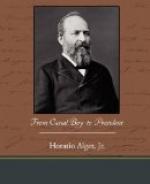This was Chester A. Arthur, whose name in after years was to be associated with that of the writing-teacher, who was occupying the same room as his Presidential successor. But to James Garfield, at that time, the name meant nothing, and it never occurred to him what high plans Providence had for them both. It was one of those remarkable cases in which the paths of two men who are joined in destiny traverse each other. Was it not strange that two future occupants of the Presidential chair should be found teaching in the same school-room, in an obscure Vermont village, two successive winters?
As the reader, though this is the biography of Garfield, may feel a curiosity to learn what sort of a teacher Arthur was, I shall, without apology, conclude this chapter with the story of a pupil of his who, in the year 1853, attended the district school at Cohoes, then taught by Chester A. Arthur. I find it in the Troy Times:
“In the year 1853 the writer attended the district school at Cohoes. The high department did not enjoy a very enviable reputation for being possessed of that respect due from the pupils to teacher. During the year there had been at least four teachers in that department, the last one only remaining one week. The Board of Education had found it difficult to obtain a pedagogue to take charge of the school, until a young man, slender as a May-pole and six feet high in his stockings, applied for the place. He was engaged at once, although he was previously informed of the kind of timber he would be obliged to hew.
“Promptly at nine o’clock A.M. every scholar was on hand to welcome the man who had said that he would ’conquer the school or forfeit his reputation.’ Having called the morning session to order, he said that he had been engaged to take charge of the school. He came with his mind prejudiced against the place. He had heard of the treatment of the former teachers by the pupils, yet he was not at all embarrassed, for he felt that, with the proper recognition of each other’s rights, teacher and scholars could live together in harmony. He did not intend to threaten, but he intended to make the scholars obey him, and would try and win the good-will of all present. He had been engaged to take charge of that room, and he wished the co-operation of every pupil in so doing. He had no club, ruler, or whip, but appealed directly to the hearts of every young man and young lady in the room. Whatever he should do, he would at least show to the people of this place that this school could be governed. He spoke thus and feelingly at times, yet with perfect dignity he displayed that executive ability which in after years made him such a prominent man. Of course the people, especially the boys, had heard fine words spoken before, and at once a little smile seemed to flit across the faces of the leading spirits in past rebellions.
“The work of the forenoon began, when a lad of sixteen placed a marble between his thumb and finger, and, with a snap, sent it rolling across the floor. As the tall and handsome teacher saw this act, he arose from his seat, and, without a word, walked toward the lad.




